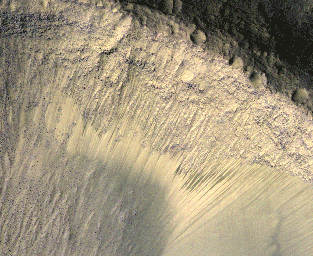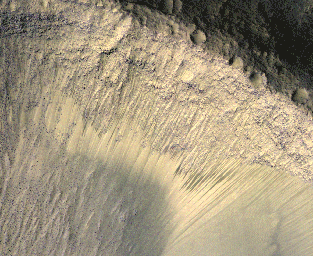
|
Seasonal Changes in Dark Marks on an Equatorial Martian Slope
- Click the image above for a larger view
 Movie Download Options
Movie Download Options- Full-Res JPEG (1653 x 1352) (426.6 kB)
- Full-Res TIFF (1653 x 1352) (2.2 MB)
Caption:
These images from the High Resolution Imaging Science Experiment (HiRISE) camera on NASA's Mars Reconnaissance Orbiter show how the appearance of dark markings on Martian slope changes with the seasons. The marks, called recurrent slope linea, extend down slopes during warmer months and fade away during cooler months. This animation shows the same location at several times of year. The location is in a crater on the floor of Valles Marineris, near the Martian equator.
Background Info:
HiRISE is one of six instruments on NASA's Mars Reconnaissance Orbiter. The University of Arizona, Tucson, operates the orbiter's HiRISE camera, which was built by Ball Aerospace & Technologies Corp., Boulder, Colo. NASA's Jet Propulsion Laboratory, a division of the California Institute of Technology in Pasadena, manages the Mars Reconnaissance Orbiter Project for the NASA Science Mission Directorate, Washington.
Cataloging Keywords:
| Name | Value | Additional Values |
|---|---|---|
| Target | Mars | |
| System | ||
| Target Type | Planet | |
| Mission | Mars Reconnaissance Orbiter (MRO) | Mariner |
| Instrument Host | Mars Reconnaissance Orbiter | |
| Host Type | Orbiter | Flyby Spacecraft |
| Instrument | High Resolution Imaging Science Experiment (HiRISE) | |
| Detector | ||
| Extra Keywords | Color, Crater, Movie | |
| Acquisition Date | ||
| Release Date | 2013-12-10 | |
| Date in Caption | ||
| Image Credit | NASA/JPL-Caltech/Univ. of Arizona | |
| Source | photojournal.jpl.nasa.gov/catalog/PIA17606 | |
| Identifier | PIA17606 | |

